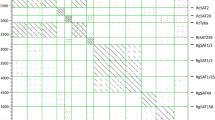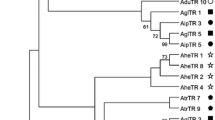Abstract.
In the nematode genus Ascaris the germline genome contains considerable amounts of extra DNA, which is discarded from the somatic founder blastomeres during early cleavage. In Parascaris univalens the haploid germline genome is contained in one large compound chromosome, which consists of a euchromatic region containing the somatic genome flanked by large blocks of heterochromatin. Fluorescence in situ hybridization of fractions of the germline-limited satellite DNA revealed two highly repeated sequence families establishing the entire heterochromatin (HET blocks). The repeats, a pentanucleotide, TTGCA, and a decanucleotide, TTTGTGCGTG, constitute separate segments of the HET blocks. The blocks are polymorphic in length and, hence, in copy number of the repeats, and the arrangement of the segments. The numerous sequence variants of both repeats display a disperse distribution. The type and rate of base substitutions within both repeat units depend on position. Prior to the elimination process in presomatic cells, termed chromatin diminution, the chromosomes undergo differential mitotic condensation. Interstitial 'chromatin linkers' flanking the prospective numerous somatic chromosomes remain entirely decondensed. The somatic chromosomes are released from the plurivalent chromosomes via excision of the linkers at onset of anaphase, followed by exclusion of the akinetic linker chromatin and HET blocks from the daughter nuclei. In Ascaris suum, the germline-limited satellite, which consists of one 123 bp repeat, is scattered throughout the numerous chromosomes in small heterochromatic knobs of variable sizes, residing at chromosomal ends and/or intercalary positions. The programmed breakage, which appears to proceed in a similar manner to that in P. univalens, results in the loss of all heterochromatic knobs, accompanied by an increase in chromosome number. In both species, all germline chromosomes are capped by tracts of TTAGGC repeats. In P. univalens, such telomeric tracts also occur at the termini of the euchromatic intercalary regions. Upon diminution all telomeric tracts are discarded. De novo telomere addition occurs in all somatic cell lineages of both species. The presented data shed light on the evolutionary history of chromosome aggregation and satellite DNA formation, and putative mechanisms involved in the process of site-directed breakage to reestablish stable somatic chromosomes.
Similar content being viewed by others
Author information
Authors and Affiliations
Additional information
In revised form: 17 May 2000
Electronic Publication
Rights and permissions
About this article
Cite this article
Niedermaier, J., Moritz, K. Organization and dynamics of satellite and telomere DNAs in Ascaris: implications for formation and programmed breakdown of compound chromosomes. Chromosoma 109, 439–452 (2000). https://doi.org/10.1007/s004120000104
Received:
Accepted:
Issue Date:
DOI: https://doi.org/10.1007/s004120000104




